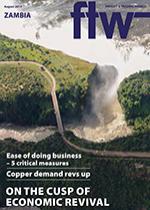South African trade and industry minister Rob Davies says the government wants to increase imports from Zambia in order to even the balance of trade between the two countries.
He made the statement shortly before heading a trade delegation which visited Zambia in July.
Zambia is one of South Africa’s top five trade partners in the Southern African Development Community region with total bilateral trade amounting to R33 billion in 2016, according to the statement. Accounting for 7.6% of Zambian exports, South Africa was the country’s fourthbiggest export market in 2015 after Switzerland (44%), China (14%) and Singapore (7.8%).
This reflects the dominance of copper as an export earner for the Zambia. However, exports to South Africa have dropped considerably since 2015, according to John Kalumbi, director of census and statistics. In his July review Kalumbi says Switzerland remains the biggest destination (45%), followed by China (17.5%), Singapore (7%), the Democratic Republic of Congo (6.2%) and United Arab Emirates (3.7%). South Africa is not mentioned. South Africa accounted for 30% of Zambian imports in June, followed by the DRC (19.7%) and China (10.5%).
The highest value of exports to Zambia were mining and transportrelated. Looking at the statistics it is difficult to see how South Africa can increase imports from Zambia.
In June 2017 Zambia’s main exports apart from copper were manganese ores/concentrates with a manganese content of greater than 20%, which accounted for 8.8% of exports, followed by cobalt oxides and hydroxides; commercial cobalt oxides in bulk (7.8%).
Other “nontraditional exports” identified by Kalumbi were raw cane sugar (5.5%) and semi manufactured forms of gold bullion (4.8%).
According to the Zambia high commissioner to South Africa, Emmanuel Mwamba, there are over 100 South African companies currently operating in Zambia.
Speaking at the start of a trade and investment forum that was part of the visit headed by Davies he called on South African companies to partner with Zambian companies in order to increase penetration of the South African market.
INSERT
Zambia’s biggest import sources


